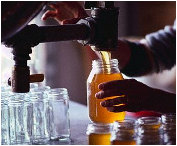 |
 |
There are quality standards that can be defined as absolute and others related to our taste or to the specific use of the product. The first parameter of quality is genuineness and healthiness: however, this case does not pose a problem; from this point of view, choosing honey is equivalent to choose an optimal product.
Honey is genuine by definition, as the trade name of honey is permitted by law only for the product made by honey bees from the nectar or honeydew: in other words, no artificial honey or honey made with sugar exist; products of this kind can not be legally marketed. Doing this means to commit a (not very convenient) fraud.
It is not permitted to add any other product to honey marketed as such.
Therefore, as there would be no need, no preservatives can be added. Even colouring or flavouring honey is not permitted: the aroma and colour of honey are exclusively those derived from plants visited by honey bees. Honey is also one of the foodstuffs who can give more assurances for the presence of any residues of foreign substances. Even in this case the legislation, with its restrictive rules, acts as a guardian to public health, albeit is honey in its very nature necessary to ensure healthiness. Good keeping quality of the product, which is connected to a low water content, is another criteria for quality. From this point of view, the beekeeper or the dealer are in charge of selecting honey in order to ensure its quality. In this case, the law is very permissive, but it is also the producer's interest not to market products that are likely to ferment. The fermented honey is already easily recognizable from its foamy appearance, with gas bubbles inside and a possible separation between the liquid and solid components. The smell and taste of acid and fermentation possibly confirm the diagnosis. Even a honey with excess moisture, which is not yet altered but prepared to fermentation, can be easily identified by excessive liquidity
Another important quality parameter is freshness: in order to assess it, it would be necessary to know the production date or that of a preferential term of consumption. Unfortunately, it is not required to affix this type of indications on the label. Often, the manufacturer provides this information, making a more a comprehensive label, and so reporting his care of the product and attention to the consumer. Beyond this information, a symptom of aging and of a temperature of storage too high is the separation of stages, which manifests as a layer of liquid honey in the surface of the crystallised product.
Even products that have undergone thermal treatment must be considered impoverished compared to the equivalent not heated. Better to beware of a product presented in liquid form in a season in which it would be reasonable to imagine it already crystallised. Unless it is Robinia (Acacia) honey, chestnut or honeydew, in all likelihood it has been melted.
For what concerns the production of honey, it is worth remembering that Italy is not self-sufficient: about 50% of consumption is supported by imports. Most of the imported honey comes from non-EU countries having more favourable conditions in terms of environment productivity and different social and economical structure: products from these countries arrive on the Italian market at a price which is much less than the cost of production in Italy. Most of the imports, especially of multi-floral honey, come from Latin America, Eastern Europe and China. The most imported mono-floral honey is the Acacia honey, especially from Hungary, Romania and China.
In terms of objective quality, a greater or lesser value of Italian honey or of the imported ones cannot be established. It is more plausible to imagine a greater freshness for products of our own country than for those having run thousands of kilometers. Unquestionably, there are appreciable differences in the organoleptic characteristics and it is important that the consumer is able recognize the different products at the time of purchase. In addition, honey produced in countries where the technological level is still very low are characterized by constant defects at the organoleptic level (e.g. taste of iron).
On the other hand, the imported product constantly presents two interesting features: the first is the cost compared to national products, and the second is the remarkable consistency from one batch to another and from year to year, due to different conditions and productive selection made from the start. These conditions make it the favorite product for most industrial users. Even at the craft level (pastry laboratories, bakers) or at home for the preparation of desserts which must be cooked and for which the use of an expensive honey would be a luxury, the quality / price ratio may make the imported product the preferred one. But for those who truly appreciates honey, the great variability of the product of our country is the most valuable
feature: the search for new flavors will be one of the reasons for choosing the Italian honey.
Many of the quality features depend on the producer - packer: the choice of a reliable company is not without importance. The choice of the producer is very important especially for those aspects for which the consumer is not protected by current law (the naming of mono-floral honey, freshness). Often, conscientiousness of the producer can be measured on the completeness and clarity of its label.
|
|
 |
|


